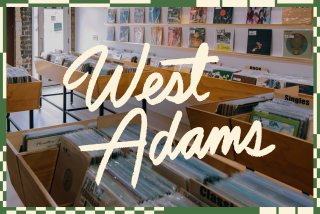STRUCTURES : The Mitchell Block : Irish immigrant brothers built a cluster of 19th-Century family homes in Ventura on what is now Thompson Boulevard.
- Share via
Let it not be said that Ventura doesn’t respect its elders. Historical interest runs fairly hot in the city, while much of Southern California reels, dizzily, from life in the developmental fast lane.
A leisurely drive in the downtown area reveals a number of fine architectural remnants of an earlier era, particularly of Victorian vintage. Many of them are well-maintained, freshly and fastidiously painted.
But, in terms of domestic architectural preservation, there is nothing so impressive as the embarrassment of historic riches known as the Mitchell block, on the 600 block of East Thompson Boulevard (between Chestnut and Fir streets, across from Plaza Park).
There it sits, like a little oasis of history sandwiched between the freeway and surrounding motels. If you sneeze or keep your eyes on the road as you head down Thompson, you might miss it. But once you take a look, it’s hard not to appreciate the sheer disarming concentration of architectural antiquity.
These eight houses, including two rare pre-1900 brick structures and other variations on Queen Anne, Craftsman and Colonial styles built before 1925, would be notable as individual examples of bygone architecture.
As it is, the Mitchell block exists as a distinctive showpiece of fine old houses all-in-a-row. If you didn’t know better, it could be assumed that these contiguous houses were artificially transplanted to one spot, as was done in the recently completed Heritage Square in Oxnard.
But this is the block the Mitchells built. Irish immigrants who settled in Ventura in the 1870s, Edward, John and Thomas Mitchell were brothers who made a living making bricks (Edward also worked as a saloonkeeper). They worked on local commercial buildings, and also found work on chimneys and fireplaces.
In the mid-1880s, John and Thomas bought up the block of property on what was then known as Meta Street and built two brick houses. In part, they were speculating on the anticipated population boom in Ventura following the arrival of the Southern Pacific railroad.
Population swelled, but the real estate boom wasn’t as thunderous as expected. The Mitchells sold off their property in 1904 and 1905, after which the remaining lots were filled with houses.
The Conklin house, the only one of the lot designated as a city landmark, sits on the north end of the block. It’s a bookend in sharp contrast with the all-brick house, circa 1886, at the opposite end of the block. With its shallow portico along a severe flat facade and its large Dutch gambrel roof, the Conklin house refers to an older mode of architecture.
But it has less inherent interest than the brick house. This unusual house, designed by architect T. B. Steepleton and built for Edward Mitchell’s son, John, entails a compact but ornate composition with gabled roofs, decorative frills, quoins on the corners, and long, tall Italianate windows.
It serves as a testament to the freewheeling stylistic breadth in late 19th-Century architecture, and also to the beauty of masonry, that lost art.
Freer yet is the striking and somewhat bizarre house at 670 Thompson, built of brick in 1890 for Mary Mitchell, Edward’s daughter. (Needless to say, at one time life on this block was a family affair.)
Here, elements of more shamelessly expressive branches of Victorian architecture, Queen Anne and Eastlake, guide the design. A hybrid creation that packs a lot of visual and spatial info into a small lot, the house is odd even by Queen Anne standards.
Strangely enough, anchoring the structure’s form is a Gothic tower, situated in the middle of the house’s interweaving volumes and gabled roofs.
More standard variations and hints of classical decorum define the rest of the block.
Often, it is the nuances that count and leave an impression on the observer: the Craftsman restraint and deep porch under a hip roof at 632 Thompson; the curved wraparound window at 682; the stretch of stone wall and exposed bungalow eaves at 620.
The pertinent truism, that they don’t make ‘em like that anymore, is only part of the story in the Mitchell block. They don’t preserve ‘em en masse like that anymore, either.
If you can shut out the pervasive rumble of the freeway a stone’s throw away, you can imagine a simpler, more architectural, elegant life in the neighborhood.
More to Read
Sign up for Essential California
The most important California stories and recommendations in your inbox every morning.
You may occasionally receive promotional content from the Los Angeles Times.





![Vista, California-Apri 2, 2025-Hours after undergoing dental surgery a 9-year-old girl was found unresponsive in her home, officials are investigating what caused her death. On March 18, Silvanna Moreno was placed under anesthesia for a dental surgery at Dreamtime Dentistry, a dental facility that "strive[s] to be the premier office for sedation dentistry in Vitsa, CA. (Google Maps)](https://ca-times.brightspotcdn.com/dims4/default/07a58b2/2147483647/strip/true/crop/2016x1344+29+0/resize/840x560!/quality/75/?url=https%3A%2F%2Fcalifornia-times-brightspot.s3.amazonaws.com%2F78%2Ffd%2F9bbf9b62489fa209f9c67df2e472%2Fla-me-dreamtime-dentist-01.jpg)







